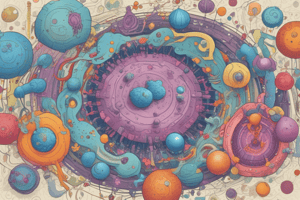Podcast
Questions and Answers
What are the two main types of autoimmune diseases mentioned in the text?
What are the two main types of autoimmune diseases mentioned in the text?
- Organ specific and non-organ specific (correct)
- Systemic and localized
- Rheumatoid arthritis and Grave's disease
- Genetic and environmental
Which genetic factor is associated with rheumatoid arthritis according to the text?
Which genetic factor is associated with rheumatoid arthritis according to the text?
- Superantigen production
- HLA-DRB1 (correct)
- Molecular mimicry
- Vascular or cellular barriers
Which host factor makes some autoimmune diseases more common in females?
Which host factor makes some autoimmune diseases more common in females?
- Gender (correct)
- Alteration of self molecules
- Infection disrupting peripheral tolerance
- Damage to immunologically privileged sites
Which environmental factor can alter self molecules to become immunogenic?
Which environmental factor can alter self molecules to become immunogenic?
Which mechanism is a theoretical possibility where foreign and self-peptides have sequence similarities, leading to cross-activation of autoreactive cells?
Which mechanism is a theoretical possibility where foreign and self-peptides have sequence similarities, leading to cross-activation of autoreactive cells?
What is the definition of an autoantibody according to the text?
What is the definition of an autoantibody according to the text?
Where does central T cell tolerance occur?
Where does central T cell tolerance occur?
What happens to T cells that fail to recognize and bind to self-MHC molecules during central tolerance?
What happens to T cells that fail to recognize and bind to self-MHC molecules during central tolerance?
Which mechanism is involved in peripheral T cell tolerance for autoreactive T cells that escape central tolerance?
Which mechanism is involved in peripheral T cell tolerance for autoreactive T cells that escape central tolerance?
Which mechanism is involved in central B cell tolerance?
Which mechanism is involved in central B cell tolerance?
What is the primary mechanism of peripheral B cell tolerance?
What is the primary mechanism of peripheral B cell tolerance?
What characterizes an autoimmune disease?
What characterizes an autoimmune disease?
What is immunological tolerance?
What is immunological tolerance?
Where does central tolerance occur?
Where does central tolerance occur?
What is the primary role of T cell tolerance?
What is the primary role of T cell tolerance?
Why is it necessary for the immune system to discriminate between self and non-self?
Why is it necessary for the immune system to discriminate between self and non-self?
What is the difference between central and peripheral tolerance?
What is the difference between central and peripheral tolerance?
Why do developing lymphocytes express a large number of antigen receptors without bias towards specificity?
Why do developing lymphocytes express a large number of antigen receptors without bias towards specificity?
Flashcards are hidden until you start studying




